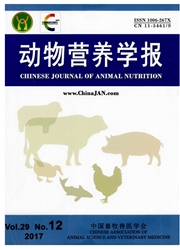

 中文摘要:
中文摘要:
本试验旨在研究妊娠期不同营养水平对初产母猪繁殖性能和乳成分的影响。选用日龄、体重接近的"长×大"二元杂交母猪44头,配种后按体重随机分为4个组,这4组按照妊娠期母猪摄入的不同营养水平分别为75% NRC组、NRC组、125% NRC组、150% NRC组,每组11个重复,每个重复1头母猪,泌乳期自由采食。结果表明:1)母猪妊娠期营养水平对总产仔数无显著影响(P〉0.05),150% NRC组窝产活仔数有低于125% NRC组的趋势(P=0.081),125% NRC组窝产健仔数、初生窝重显著高于75% NRC组(P〈0.05),有高于150% NRC组的趋势(P=0.083,P=0.090),但与NRC组差异不显著(P〉0.05)。2)母猪妊娠期总增重、净增重及配种-断奶增重各组之间差异极显著(P〈0.01),随着妊娠期营养水平摄入的提高,泌乳期失重随之增加(P〈0.01)。3)母猪泌乳期平均日采食量随妊娠期营养水平摄入的增加而降低,泌乳期消化能摄入量Y3(MJ/d)与妊娠期消化能摄入量X(MJ/d)的回归关系为:Y3=75.60-0.743X(R2=0.572,P〈0.01)。4)随着妊娠期营养水平摄入的提高,母猪初乳中乳脂、乳蛋白含量随之极显著增加(P〈0.01),常乳中乳脂、乳蛋白含量以125% NRC组最高,营养水平的摄入与乳脂、乳蛋白含量呈二次曲线关系(P〈0.01)。结果提示,妊娠期125% NRC水平的营养摄入可改善初产母猪繁殖性能及常乳品质。
 英文摘要:
英文摘要:
This experiment was conducted to study the effects of different nutrient levels during pregnancy on reproductive performance and milk composition of primiparous sows. Forty-four crossbred sows (Landrace譟orkshine) with similar age and body weight were randomly allocated into four groups with different nutrient intake levels (75% NRC, NRC, 125% NRC and 150% NRC) during pregnancy, and every group had 11 replicates with 1 sow in each replicate. All sows were fed ad libitum during lactation. The results showed as follows: 1) nutrient intake levels of sows during pregnancy did not affect total litter size born per litter (P〉0.05), but the piglet born alive per litter in 150% NRC group had a trend to be less than that in 125% NRC group (P=0.081). The number of piglet born healthy per litter and litter weight at birth in 125% NRC group were significantly higher than those in 75% NRC group (P〈0.05), and had a trend to be higher than those in 150% NRC group (P=0.083,P=0.090), but were not significantly different compared with NRC group (P〉0.05). 2) Total weight gain during pregnancy, net weight gain during pregnancy and breeding-weaning weight gain were significantly different among all groups (P〈0.01), and with nutrient intake levels during pregnancy improving, weight loss during lactation was significantly increased (P〈0.01). 3) With nutrient intake levels of sows during pregnancy increasing, average daily feed intake during lactation was decreased, and regression relationship between digestible energy intake of lactation Y3 (MJ/d) and digestible energy intake during pregnancy X (MJ/d) was Y3=75.60-0.743X(R2=0.572,P〈0.01). 4) Milk fat and protein contents in colostrum were increased with dietary nutrient intake levels during pregnancy increasing (P〈0.01), but the contents of milk fat and protein in 125% NRC group were the highest, and regression relationship between nutrient levels and milk fat and protein contents was quadratic (P〈0.01).
 同期刊论文项目
同期刊论文项目
 同项目期刊论文
同项目期刊论文
 期刊信息
期刊信息
